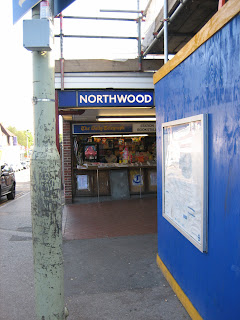All of the stations, apart from the terminus, were pretty much deserted when I passed this way. It was late on a Saturday afternoon, and dusk was creeping in. Nobody seemed much gripped by an enthusiasm to travel anywhere local. Groups of teenagers were heading into London for the night; groups of shoppers were heading back home to Uxbridge. In-between, little happened.
This was the last stretch of the Metropolitan to be built, in 1904. Many of its stops weren't added for several years. One didn't materialise for almost two decades. The whole branch has a sparse, uncluttered feel. Nobody travels this way out of pleasure.
West Harrow didn't become a station until nearly 10 years after the line arrived. Unashamedly small, it feels almost apologetic for existing.
Nonetheless it can play host to the most spectacular of sunsets.

Rayners Lane, its neighbour, is the point at which the Piccadilly line, heading up from Sudbury, joins the Metropolitan and shares its tracks all the way to Uxbridge.
When it opened the place was called Rayners Lane Halt, and served a few scattered village cottages and little else. Harrow Garden Village slowly washed up around it, and the station was finally remade in the 1930s by Charles Holden, whose buildings I've met before, and who made sure to stamp his signature motifs - the flat roof, the geometric shapes, the glass ticket hall - here as elsewhere.
By necessity it's a sprawling place, but not especially bustling, the trains shunting to and fro at their own pace with little sense of wanting to go anywhere. Well, to go anywhere fast. The sun was sinking low when I stopped off, casting the whole place into deep, sentimental shadow.
Eastcote is also Charles Holden's handiwork, bordered, as seems so often to be the case along this line, by tiny antiquated-looking businesses and musty corner shops that nobody goes in.
Ruislip Manor is the same, albeit lacking the grandeur its name implies.

Ruislip was, for a time, the only stop between Harrow and Uxbridge and has, perhaps understandably, more of the look and feel of a proper branch line station than its predecessors:
Ickenham was the next to open in chronological terms, but you wouldn't think it surveying its dismal structure today. The building was completely demolished and rebuilt in the 1970s. It's surely one of the grottiest and most unwelcoming edifices on the whole Metropolitan line.
Except for the platforms, that is:

Hillingdon was the last stop to be added to this branch of the line and therefore the last new station to be added to the Metropolitan in its entirety.
It spent two decades loitering under the name of Hillingdon (Swakeleys), and is still referred to as such on signs on the platforms. Its present condition, though, is far removed from its antecedent, and literally so. In 1992 an entirely new version of Hillingdon station was opened, south of the original, to enable the A40 to be expanded and re-routed. As such you can now stand on the platform and, rather eerily, watch one of London's major arterial roads rumble beneath you. It's a fantastically designed place, full of gleaming corridors and giant walkways that won it the title of Underground Station of the Year 1992, but which seem utterly at odds with its location out in the middle of nowhere, hard to reach, and next to a dual carriageway.
Finally, then, to Uxbridge, where the Metropolitan came to rest on 4th July 1904, a little way to the north of where the station is today. Its present form is another Holden creation, topped off by a pair of sculptures over the entrance depicting giant mechanical wheels with leaf springs.
It's a cavernous, rather impressive place, totally at odds with its immediate surroundings - Uxbridge's noisy, ramshackle shopping precinct - and, with its stained glass and canopy roof, seems to have arrived straight from another age.
And that was it. The end of the Metropolitan line. No more tiny branches to investigate, no more dead ends to explore, no more Metro-land lingering over the horizon. It felt like an epic trek was concluding in, as usual, a profoundly underwhelming fashion. Uxbridge town centre, despite once being the setting for Press Gang - the best children's TV series ever - was no gold at the end of the rainbow. The value of this excursion had been the journey itself, not the arrival at a destination. All change, please. All change.




























